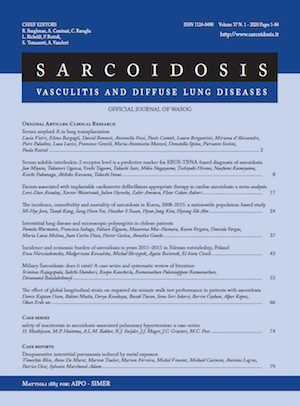Desquamative interstitial pneumonia induced by metal exposure A case report and literature review.
Main Article Content
Keywords
Interstitial lung disease, Desquamative interstitial pneumonia, Metal analysis, Aluminium lung, Zirconium lung
Abstract
Background: Forms of interstitial pneumonia secondary to exposure to an air-contaminant are varied and so far, insufficiently described. Objectives/Methods: We report here a case of a 57-year-old patient managed in our department for the exploration of MRC grade 2 dyspnoea and interstitial pneumonia. He mentioned multiple occupational and domestic exposures such as hens’ excrements, asbestos and metal particles; he also had a previous history of smoking. Results: High-resolution computed tomography showed ground glass opacities predominating in posterior territories and surrounding cystic lesions or emphysematous destruction. The entire etiological assessment revealed only macrophagic alveolitis with giant multinucleated cells on the bronchoalveolar lavage. A surgical lung biopsy allowed us to refine the diagnosis with evidence of desquamative interstitial pneumonia and pulmonary granulomatosis. Finally, the analysis of the mineral particles in the biopsy revealed abnormally high rates of Zirconium and Aluminium. We were therefore able to conclude to a desquamative interstitial pneumonia associated with pulmonary granulomatosis linked to metal exposure (Aluminium and Zirconium). The clinical, functional and radiological evolution was favorable after a systemic corticosteroid treatment with progressive decay over one year. Conclusion: This presentation reports the first case to our knowledge of desquamative interstitial pneumonitis related to exposure to Zirconium and the third one in the context of Aluminium exposure. The detailed analysis of the mineral particles present on the surgical lung biopsy allows for the identification of the relevant particle to refine the etiological diagnosis, to guide the therapeutic management and to give access to recognition as an occupational disease.






